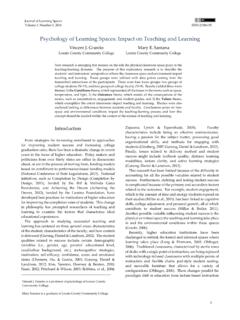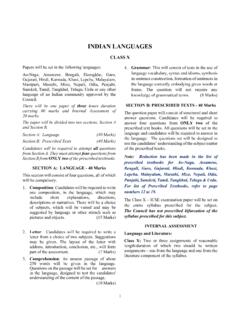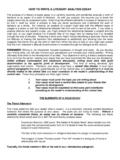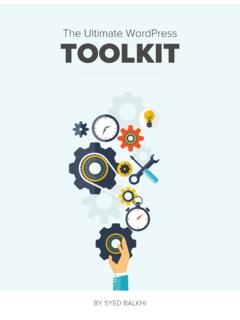Transcription of Teaching the Literature Review: A Practical Approach for ...
1 41 Teaching & Learning Inquiry, Volume 2, Issue 2, pp. 41 57, 2014. Copyright 2014 The International Society for the Scholarship of Teaching and LearningJonathan Cisco, UNIVERSITY OF MISSOURI, the Literature Review: A Practical Approach for College Instructors aBSTraCT Instructors across the disciplines require their students to write Literature reviews. although numerous sources describe the Literature review process, instructors and students face difficulty when approaching the structure of a Literature review. This paper presents a straightforward, efficient Approach for Teaching students how to write a Literature review.
2 Developed over the course of three years at a university writing center, this lesson received substantial support from students across the disciplines. This paper reflects on one group of students experiences while writing Literature reviews in a po liti cal science course, showing that students demonstrated a sense of confidence and direction after the lesson. university professors, writing center staff, and content- discipline instructors in higher edu-cation classrooms can alleviate their students anxiety about Literature reviews by using this lesson in their classrooms. KeyWOrDS Literature review, college writing, college Teaching , disciplinary writing, writing centerTutor: What does the term Literature review mean to you?
3 Jessica: God, I don t know. I don t have sense of structure. It s a synthesis and summary, I know : You explain and describe the recent theories and something like that. I don t know, man. I guess I talk about specific details and things. But how far do I go? I mean, that could take forever. I worked at the writing center of a major university for several years. Students who sought my assistance of en requested help on how to write a Literature review that had been assigned by one of their instructors. At the beginning of our one- on- one, 50- minute session, I of en asked the student to define a Literature review. The students [pseudonyms] responses above are typical of what I heard confusion and uncertainty.
4 Therefore, my task as a writing tutor was first to demystify student misunderstandings toward the litera-ture review and sec ond to teach them to write a coherent, thoughtful reviews are a common writing assignment in four- year university courses, junior college courses, and graduate education (Ridley, 2008); however, the process 42 Teaching & LearnIng InquIry, VOL. 2014 Ciscoof writing in college (Gruenbaum, 2012), and particularly writing Literature reviews, can be intimidating and confusing for students (Ridley, 2008; Feak & Swales, 2009). Even though the Literature review is a hallmark of scholarly research, students may have difficulty even defining the term.
5 Furthermore, students find it challenging to synthe-size works in a Literature review and thus are unable to write a coherent review. Above all, my tutoring experience has shown that students of en have difficulty with the struc-ture of the Literature review; they typically write a series of unrelated paragraphs, each of which summarizes one of the works reviewed rather than an integrative analy sis of all the is the purpose of this article to present an Approach I developed for Teaching stu-dents how to write Literature reviews: the Literature Review Lesson (LRL). I have found the LRL to be a Practical and efficient Approach because it emphasizes the structure of a Literature review the nemesis of novice writers and how students can use the dis-ciplinary literacy (Shanahan & Shanahan, 2008) within their particular content areas ( , history, biology, Literature , psychology) as they write their reviews.
6 Focusing on the structure of a Literature review, however, does not mean ignoring content; rather, the LRL seeks to create a flexible template that assists students use of content (Birkenstein & Graff, 2008). I developed the LRL over three years as I worked with students. I cre-ated a prototype lesson, implemented it, and evaluated it several times coinciding with methods that make the tutoring session effective (Bloom, 1984; Fullmer, 2012; Grogan, 2011; Reinheimer & McKenzie, 2011; Wood & Wood, 1996). Through these iterations, I found the LRL to be increasingly the following sections, I review and reflect (Schon, 1984) on the research, theory, and guidebooks on writing Literature reviews, indicating gaps that may explain student confusion.
7 Afer describing my methodology, I present the LRL in full. I also provide comments my students made during tutoring sessions about Literature reviews before, during, and afer I taught the LRL (Seidman, 2006), gathered in accordance with IRB approval. I conclude by discussing how the LRL can be adapted to the classroom anD TheOry On WrITIng Literature reVIeWSDefinition and structureLiterature review is defined in many ways. Some writers have defined Literature re-view by its process (Riley, 1997), order (Machi & McEvoy, 2009), or categories, (Zorn & Campbell, 2006). Others view it as a combination of analy sis, synthesis, and summary (Hart, 1998).
8 Thus, college writers and instructors may find the multiple definitions confusing. During one of the tutoring sessions, Jessica echoed the confusion, stating, I don t know. I m just so lost. I thought it was something not like a summary, but I don t know what I m doing. Rachel, another tutee, had difficulty finding a definition, saying, I googled Literature review, in hopes of figuring out what it is, but I didn t find anything helpful. It all used the same words. In this paper, I define a Literature review as a thematic synthesis of sources used to provide readers with an up- to- date summary of theoretical and empirical findings on a particular is also a lack of consensus regarding the structure of a Literature review (Zorn & Campbell, 2006).
9 Galvan (1999) encouraged students to organize their initial out-43 Teaching THE LITE TURE REVIEW line topically, whereas other authors emphasized the importance of themes (Rocco & Hatcher, 2011). Pan (2008) suggested that some Literature reviews may require multiple organizational themes. In the tutoring session, it is the structure, not the content, that typically seems to confuse students. When discussing structure, several students seemed desperate, responding with oh, my God. I have a real sense of hopelessness and I m just so lost..I don t know what I m doing. Billy and Wendy admitted that their ap-proaches would be improvised: I fig ured I d just wing it and my attempt would be a total shot- in- the- dark.
10 Many scholars recommend that themes become headings in the paper to provide writers with a structure and readers with organizational cues (Galvan, 1999; Pan, 2008; Ridley, 2008). Experience with the LRL shows that creating theme- based subheadings helps the inexperienced writer from straying off topic without stifling student origi nality in the review. Students of en conceive of Literature reviews as a process of summarizing, rather than a process of analy sis and synthesis, leading writers to a single- author- per- paragraph structure (Hart, 1998) rather than organizing the Literature under specific categories or themes (Galvan, 1999).













